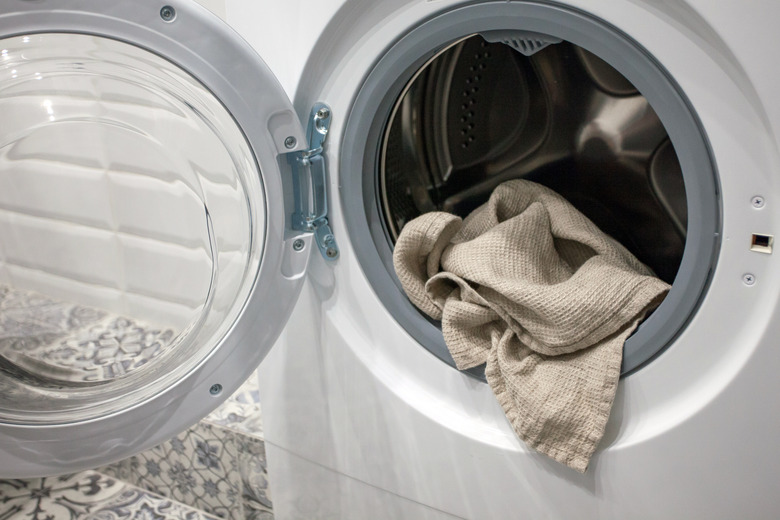How To Reset A Thermal Fuse
We may receive a commission on purchases made from links.
If you're wondering how to reset a thermal fuse because your clothes dryer overheated, you're on the right track, but a thermal fuse — as opposed to a thermal switch — is not resettable, and if one blows and the appliance stops heating or won't work at all, you have to replace it like you do an old-style electrical fuse. It isn't just clothes dryers that have thermal fuses; pretty much any appliance that heats up has one, including your washer, microwave oven, standard electrical oven, dishwasher and room heater. There's even a thermal cutoff fuse on your refrigerator because the compressor can overheat, but the blower on your central heating fan is more likely to have a resettable thermal switch.
The thermal fuse is a safety device that prevents fires by shutting off the power either to the heating element of the appliance or the entire appliance, so if your electric dryer feels unusually warm and it won't turn on, the thermal fuse has probably blown, and the dryer won't work even when the temperature drops. Replacing a thermal fuse is easy, and the replacement is inexpensive, but accessing the fuse may not be easy, and depending on where the manufacturer put it, it may require a fair amount of disassembly. In many cases, however, you can get to it by just removing the front or back panel of the appliance.
Diagnose a Blown Dryer Thermal Fuse
Diagnose a Blown Dryer Thermal Fuse
When an appliance like an electric dryer overheats and the thermal fuse blows, your first clue is usually that the appliance won't turn on. In addition to a thermal fuse, most electric dryers also have a high-limit thermostat to prevent overheating, but it typically just shuts off the heating element, and the dryer stops heating. The thermal fuse in a dryer is located near the exhaust blower, and a common cause of a blown fuse is lint buildup in the dryer vent blocking airflow, so a good way to troubleshoot the problem is to clean the exhaust vent.
Dryers can lose power for other reasons, including a blown circuit breaker or GFCI outlet, a faulty door switch or some other problem in the control panel. If the thermal switch is accessible enough, it's easy to determine whether or not it's the problem by performing a continuity test with a multimeter, so it's one of the first things to check. Some dryer designs, however, call for extensive disassembly — including removal of the dryer drum — to get to the thermal fuse, which makes it more practical to eliminate other possibilities before going to the trouble of checking the thermal fuse.
Things Needed
-
Owner's manual
-
Replacement fuse
How to Test and Replace a Dryer Thermal Fuse
1. Locate the Fuse
Study the owner's manual for the location of the thermal fuse. If you didn't save the copy that came with the dryer, you can usually find the manual on the manufacturer's website.
2. Cut Power to the Dryer
Unplug the dryer. If it's hardwired to the circuitry, turn off the double-gang 30- or 40-amp, 240-volt circuit breaker that controls the dryer.
3. Disassemble as Needed
You may be able to access the thermal fuse by unscrewing screws and removing a panel on the front or the back of the dryer. On some models, you can access the thermal fuse by pulling the dryer vent off the outlet on the back of the dryer. On some models, you may have to remove the top of the dryer and the front door and lift out the dryer drum.
4. Disconnect the Thermal Fuse
Pull the wires off both terminals of the fuse to completely disconnect it from the dryer circuitry.
5. Conduct a Continuity Test
Set the dial on a multimeter to measure resistance in ohms. Touch one probe to one of the fuse terminals and the other probe to the other terminal and note the reading. If the meter reads zero ohms, the fuse is good and doesn't need to be replaced, but if the reading shows large or infinite resistance, you need a new fuse.
6. Purchase a Replacement
The replacement fuse is model specific, so you have to get it from the manufacturer or from a third-party supplier. Two good online suppliers are RepairClinic.com and eReplacementParts.com. You'll need the make and model number of the dryer, which you can find by reading the label on the control panel or inside the door.
7. Replace the Fuse
The fuse is secured to the dryer chassis with one or two Phillips screws. Remove these screws and the fuse, set the new fuse in place and tighten the screws. Then, reconnect the electrical wires.
8. Reassemble the Dryer and Test It
Reverse the procedure you used to disassemble the dryer, plug in the appliance and turn it on to make sure it runs.
